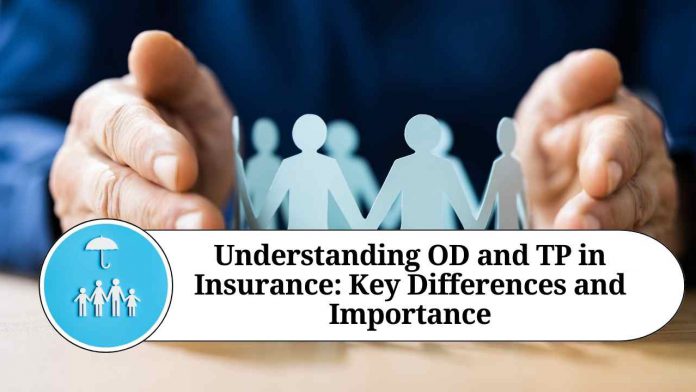Introduction
When it comes to insurance, it’s important to familiarize yourself with various terminologies to make informed decisions. Two commonly encountered terms in the insurance industry are OD (Own Damage) and TP (Third Party) coverage. Understanding the differences between OD and TP is crucial for selecting the right insurance policy that suits your needs. In this blog, we will explore the concepts of OD and TP in insurance, highlighting their key differences and their significance in protecting your assets and liabilities.
Own Damage (OD) Coverage:
Own Damage coverage, as the name suggests, provides financial protection against damages to your insured vehicle. It encompasses any loss or damage that occurs to your vehicle due to accidents, theft, fire, vandalism, or natural disasters, among other specified perils. OD coverage is an optional component of an insurance policy, especially in comprehensive plans, and helps safeguard your vehicle from unexpected expenses.
Key Features of OD Coverage:
a) Accident Coverage: OD coverage includes protection against damages resulting from accidents, whether it’s a collision with another vehicle or a single-vehicle accident. b) Theft: If your vehicle is stolen, OD coverage provides compensation for the loss based on the terms and conditions of the policy. c) Fire and Natural Calamities: OD coverage extends to damages caused by fire, floods, earthquakes, cyclones, or other natural disasters. d) Vandalism: In case your vehicle is intentionally damaged or vandalized, OD coverage will bear the repair costs.
Third Party (TP) Coverage:
Third Party coverage refers to the insurance coverage provided to protect you from legal liabilities arising due to damages caused to a third party by your insured vehicle. In simpler terms, it covers your financial obligations towards others if you are held responsible for causing property damage, bodily injury, or death while using your vehicle. TP coverage is mandatory in most countries to ensure protection for other road users.
Key Features of TP Coverage:
a) Property Damage: TP coverage compensates for damages caused to someone else’s property due to your vehicle’s involvement in an accident. b) Bodily Injury: If someone sustains injuries or death due to an accident involving your insured vehicle, TP coverage helps cover medical expenses, rehabilitation costs, and potential legal liabilities. c) Legal Defense Costs: TP coverage also provides coverage for legal defense costs if you face a lawsuit as a result of the accident.
Importance of OD and TP Coverage:
Having both OD and TP coverage in your insurance policy provides comprehensive protection for both your vehicle and your potential liabilities. Here’s why they are essential:
Financial Protection: OD coverage ensures that you are safeguarded against unexpected expenses arising from damages to your vehicle, which can be costly to repair or replace.
Legal Compliance: TP coverage is often mandatory by law, ensuring you meet the legal requirements of being financially responsible for damages caused to third parties.
Peace of Mind: With both OD and TP coverage, you can drive with confidence, knowing that you are protected from financial burdens arising from accidents, damages, or legal liabilities.
Conclusion
OD and TP coverage are vital components of an insurance policy, offering protection against damages to your vehicle and legal liabilities towards third parties, respectively. While OD coverage shields you from the financial impact of accidents, theft, and natural disasters, TP coverage ensures that you fulfill your legal obligations towards others. By understanding these differences and the significance of each, you can make an informed decision while choosing an insurance policy that suits your needs, providing you with comprehensive coverage and peace of mind on the road.
Read more useful content:
Frequently Ask Questions
Q. What is OD coverage in insurance?
OD (Own Damage) coverage is an optional component of an insurance policy that provides financial protection against damages to your insured vehicle. It covers losses or damages resulting from accidents, theft, fire, vandalism, or natural disasters.
Q. What does OD coverage include?
OD coverage typically includes protection against accidents (collision or single-vehicle), theft, damages caused by fire or natural calamities, and vandalism.
Q. Is OD coverage mandatory?
No, OD coverage is not mandatory. It is an optional component of an insurance policy, especially in comprehensive plans. However, it is highly recommended to have OD coverage to protect your vehicle from unexpected expenses.
Q. What is TP coverage in insurance?
TP (Third Party) coverage is a mandatory component of an insurance policy that protects you from legal liabilities arising from damages caused to a third party by your insured vehicle. It covers property damage, bodily injury, and legal defense costs.
Q. What does TP coverage include?
TP coverage includes compensation for damages caused to someone else’s property due to your vehicle, coverage for medical expenses and legal liabilities in case of bodily injury or death, and coverage for legal defense costs if you face a lawsuit.
Q. Why is TP coverage mandatory?
TP coverage is mandatory in most countries to ensure that individuals using vehicles on public roads are financially responsible for any damages they may cause to third parties. It provides protection to other road users who may suffer losses due to an accident involving your vehicle.
Q. Can I have TP coverage without OD coverage?
Yes, it is possible to have TP coverage without OD coverage. In some cases, individuals may opt for TP-only policies if they do not own a vehicle but still want to meet the legal requirements for third-party liability protection.
Q. Can I have OD coverage without TP coverage?
Generally, OD coverage is available as part of a comprehensive insurance policy that includes TP coverage. It is uncommon to have standalone OD coverage without TP coverage, as TP coverage is mandatory in most cases.
Q. What is the importance of having both OD and TP coverage?
Having both OD and TP coverage provides comprehensive protection for your vehicle and your potential liabilities. OD coverage ensures financial protection against damages to your vehicle, while TP coverage ensures you meet legal requirements and protects you from financial obligations towards third parties.
Q. Can I customize the level of OD and TP coverage in my insurance policy?
Yes, insurance companies often offer different levels of OD and TP coverage to cater to individual needs. You can discuss with your insurance provider to customize the coverage limits and select additional add-ons based on your requirements.




















